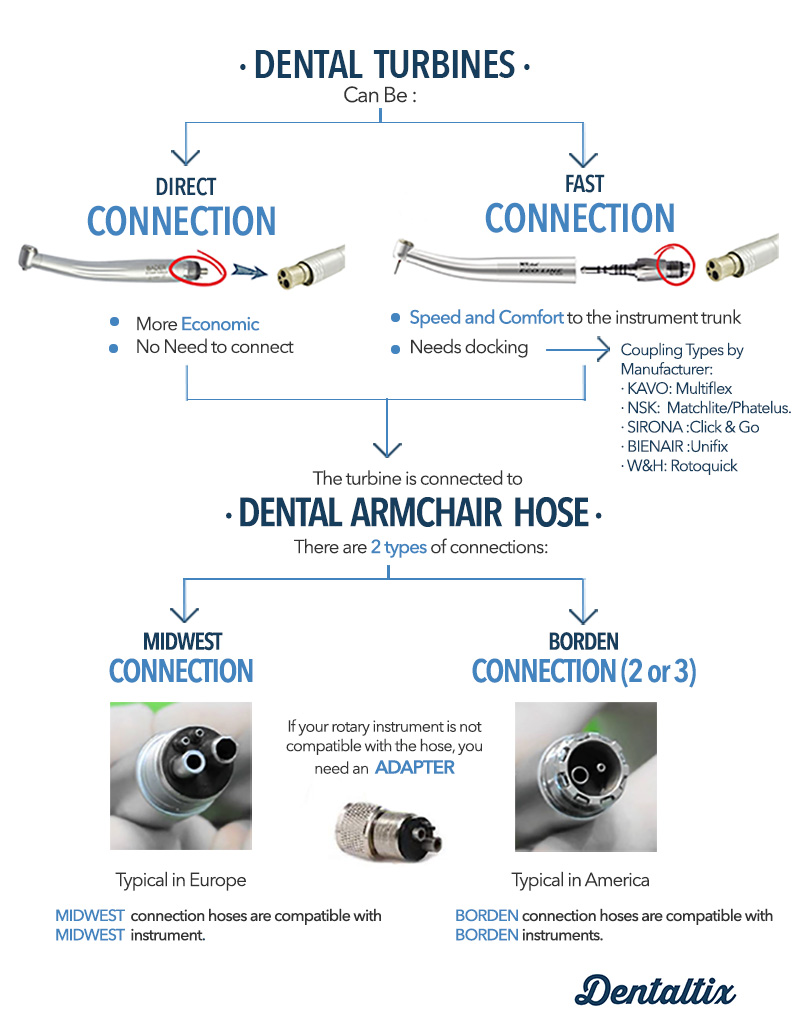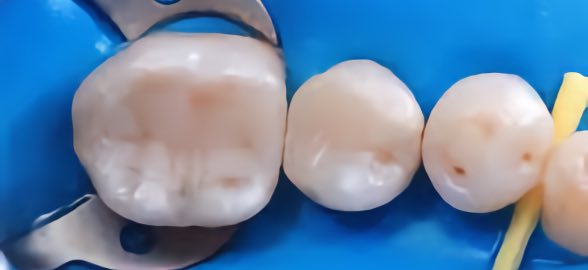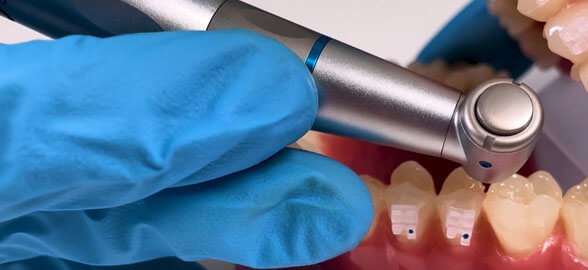Dental turbine are one of the instruments of dental appliances most used in dentistry. Turbines have multiple uses, as they can be used to remove cavities, perform tooth grinding to prepare crowns and cavities, or polish leftover composite.
One of the most important elements to take into account when choosing our dental turbine is its connection , as this will depend on whether our turbine is compatible with the dental chair we have.When it comes to connections and couplings for rotary instruments, things can get a bit confusing.
That's why, at Dentaltix, we want to help you invest your resources in the best equipment and make the right decisions, whether for your clinic or, if you are a student, for your first rotary instrument kit.
Everything you need to know about the different types of connections and their compatibility? Next!
Dental rotary instruments: types of connections
.In terms of dental turbine connections , we can differentiate two main families:
- Direct connection turbines to hose: they need to be screwed onto the dental chair hose and do not need a coupling to work, that is, every time we want to connect them to the hose we have to screw and unscrew.
- Quick connection turbines: the dental turbine is connected to the hose by means of a coupling. This coupling is screwed directly onto the hose and allows the turbine to be quickly attached to it. This connection makes it easier to exchange instruments between patients. Of course, the couplings must match the connection on your hose, as well as the connection of the corresponding brand.
- KAVO: Multiflex.
- NSK: Matchlite/Phatelus.
- SIRONA: Click & Co.
- BIENAIR: Unifix.
- W&H: Rotoquick.
This connection is distinguished into several types depending on the manufacturer:
Turbines with direct hose connection: Midwest (M4) and Borden connections
Turbines with direct hose connection are connected directly to the dental chair hose. They have the advantage that they are cheaper and do not need to have a coupling or connection. In addition, no air force is lost in the adapter, so if we do not have much air pressure in the cabinet, they may be an option to consider. As against, if we have to plug them and unplug them very often to grease or sterilize them, this will be a more cumbersome process than if they had a quick connection, since every time we will have to fit them in the hose and screw them correctly.
The hose and turbine must have compatible connections to work properly. In Europe, most dental equipment uses a hose with a Midwest connection, so ideally your rotary instruments should also be Midwest. In America, however, the Borden connection is very common. You may wonder what happens when the hose and turbine have a different connection: the answer is that you will need an adapter between these two in order to use them together.
Quick-release turbines: NSK, Kavo, Bien Air and W&H
The modern turbines from the main manufacturers usually incorporate a quick coupling connection that facilitates the connection and disconnection of the turbine. This coupling or link is connected to the hose (either this 4-hole Midwest or two-hole Borden), and is left fixed, being only the turbine that is connected and disconnected from the adapter to lubricate and sterilize it.
Each of the main brands fordental turbines has its quick coupling, compatible with the turbines of its brand, but the most widespread coupling, which is becoming a standard is the Multiflex Adaptador by Kavo. Another of the commonly used couplings are the BIEN AIR dental rotary couplings.
In order to summarize in a visual way what we have commented to you, we share this infograph that summarizes quickly, the information explained previously:

How the most common turbine connection works in Europe: Midwest
The Midwest connection system has 4 paths or holes through which air and water enter and exit your dental instrument. It has 2 lines, one for the produced air and one for the reflux air. It also has independent connections for the spraying media. Its main advantage is that the cooling spray, water and air can be regulated independently, thus adjusting to the needs of each user.
Midwest 4-Way Connection without Light
There is a hole for the backflow air to pass through. This allows the air to return to the air supply system and not have to exit through the turbine, which improves the operation of the turbine.
It also has an additional air spray inlet for cooling when polishing a tooth (top image).
Midwest 4-Way Connection with Light
This connection is very similar to the previous one (bottom image). The only difference is that it has electrical connections capable of turning on an LED, thus improving vision in the work area.

Check out the best-selling rotary couplings:
Now that you know the connections for dental turbines, we are going to briefly tell you what the connections for dental micromotors are. As you know, the handpiece and the contra-angle are connected directly to the micromotor, and this is connected to the hose.
There are two types of micromotors:
Electric micromotors
Micromotors can be electric or pneumatic. If you choose an electric micromotor, you must make sure that the hose is compatible with the model you have. Connections are usually unique for each brand, even depending on the model of the micromotor.
Pneumatic micromotors
Pneumatic micromotors have the same connection system (Midwest, Borden 2 and Borden 3) as turbines. It is worth emphasizing that the connection between the handpiece, contra-angle and micromotor is universal. All brands are compatible with each other. There is no possibility of errors here.
We hope that it will be very helpful and useful to you, whether you are an experienced professional or a student of the incredible world of dentistry. Do not forget to visit our special section for students or consult us directly by telephone or to our mail hello@dentaltix.com for any consultation or group orders.





